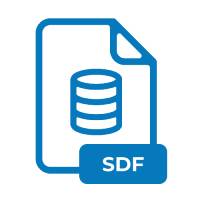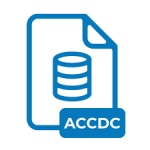.SDF File Extension

SQL Server Compact Database File
| Developer | Microsoft |
| Popularity | |
| Category | Database Files |
| Format | .SDF |
| Cross Platform | Update Soon |
What is an SDF file?
‘.SDF’ file extension stands for “Structure-Data File” or “Structure-Data Format.” It is a file format commonly associated with chemical data, specifically in the field of chemistry and molecular modeling.
‘.SDF’ files serve as a standardized way to store and exchange chemical information, making them an essential tool for researchers, chemists, and scientists working in various domains.
More Information.
The history of the ‘.SDF’ file extension is closely tied to the evolution of computational chemistry and the need for a standardized way to store and exchange chemical data.
Initially, it was designed to facilitate the storage of molecular structures, chemical properties, and other related data in a single file.
This format quickly gained popularity due to its simplicity and effectiveness in representing complex chemical information.
Origin Of This File.
The origin of the ‘.SDF’ file format can be traced back to the early days of computer-aided molecular design (CAMD) and cheminformatics.
It was developed by Molecular Design Limited (MDL), a pioneering company in the field of computational chemistry. MDL introduced the ‘.SDF’ format as part of their suite of software tools, including the widely used MDL ISIS/Draw and ISIS/Base.
File Structure Technical Specification.
The ‘.SDF’ file format is based on a plain-text structure, which makes it easily readable and editable by humans and machines alike. Its primary purpose is to store information related to chemical compounds, including:
- Molecular Structure: This typically includes information about the atoms, bonds, and connectivity of a chemical compound.
- Chemical Properties: .SDF files can store data on the physical and chemical properties of compounds, such as molecular weight, melting point, and boiling point.
- Experimental Data: Researchers can include experimental results, spectra, and other experimental data associated with the compound.
- Metadata: .SDF files often contain metadata such as compound names, identifiers, and references.
The technical specifications of an .SDF files include a header section that provides information about the number of data records, as well as a data section that stores the actual chemical information. Each data record consists of multiple lines, with specific data fields separated by delimiters.
How to Convert the File?
Converting .SDF files to other formats or from other formats to .SDF is a common requirement for chemists and researchers.
Several software tools and libraries are available to facilitate these conversions:
- Open Babel: Open Babel is an open-source chemical toolbox that supports the conversion of .SDF files to various other chemical file formats and vice versa.
- ChemAxon Marvin: ChemAxon Marvin provides a suite of cheminformatics tools, including the ability to convert .SDF files into different chemical file formats.
- RDKit: RDKit is an open-source toolkit for cheminformatics that includes functionality for handling .SDF files and performing format conversions.
- Online Converters: Numerous online services offer the ability to upload .SDF files and convert them to different formats, making it a convenient option for users without access to specialized software.
Advantages And Disadvantages.
Advantages of .SDF Files
- Standardization: The .SDF format provides a standardized way to represent chemical data, ensuring compatibility and consistency across various software applications.
- Comprehensive: It can store a wide range of information, from molecular structures to experimental data, making it versatile for chemists and researchers.
- Interoperability: .SDF files can be used with a variety of cheminformatics software, allowing for easy data exchange between different tools and platforms.
Disadvantages of .SDF Files
- Limited to Chemistry: While .SDF files are invaluable for the field of chemistry, they are not suitable for other types of data or applications.
- Complex Data Handling: Managing large .SDF files with numerous records and complex data structures can be challenging without specialized software.
- Text-Based: Being a text-based format, .SDF files may not be as space-efficient as binary formats for storing large datasets.
How to Open SDF?
Open In Windows
- ChemDraw: ChemDraw is a popular software for chemical drawing and analysis on Windows. It supports .SDF file format, allowing you to open and manipulate chemical structures.
- ChemSketch: ACD/ChemSketch is another Windows-based tool that supports .SDF files and offers chemical structure drawing and analysis capabilities.
Open In Linux
- Open Babel: Linux users can take advantage of the cross-platform Open Babel toolkit, which provides command-line tools for working with .SDF files.
- RDKit: RDKit is an open-source cheminformatics toolkit that is available for Linux and can be used to work with .SDF files.
Open In MAC
- ChemDraw: ChemDraw is available for macOS as well, providing a consistent experience with its Windows counterpart for opening .SDF files.
- Marvin Suite: ChemAxon’s Marvin Suite offers macOS-compatible software for viewing and editing .SDF files on Apple devices.













